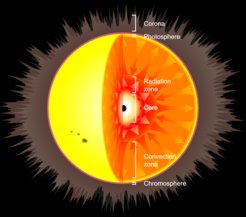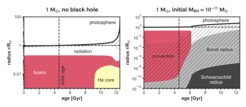What happens if you put a black hole into the Sun?
In a hypothetical scenario, small, primordial black holes could be captured by newly forming stars. An international team, led by researchers at the Max Planck Institute for Astrophysics, has now modelled the evolution of these so-called “Hawking stars” and found that they can have surprisingly long lifetimes, resembling normal stars in many aspects. Asteroseismology could help to identify such stars, which in turn could test the existence of primordial black holes and their role as a component for dark matter.
Let’s do a scientific exercise: If we assume that a large number of very small black holes where created just after the Big Bang (so-called primordial black holes), some of them might be captured during the formation of new stars. How would this affect the star during its lifetime?
“Scientist sometimes ask crazy questions in order to learn more,” says Selma de Mink, director of the stellar department at the Max Planck Institute for Astrophysics (MPA). “We don’t even know whether such primordial black holes exist, but we can still do an interesting thought experiment.”

Primordial black holes would have formed in the very early Universe with a wide range of masses, from some as small as an asteroid up to thousands of solar masses. They could constitute an important component of dark matter, as well as being the seeds for the supermassive black holes at the centre of present-day galaxies.
With a very small probability, a newly forming star could capture a black hole with the mass of an asteroid or a small moon, which would then occupy the star’s centre. Such a star is called a “Hawking star”, named after Stephen Hawking, who first proposed this idea in a paper in the 1970s. The black hole at the centre of such a Hawking star would grow only slowly, as the infall of gas to feed the black hole is hampered by the outflowing luminosity. An international team of scientists has now modelled the evolution of such a star with various initial masses for the black hole and with different accretions models for the stellar centre. Their astonishing result: when the black hole mass is small, the star is essentially indistinguishable from a normal star.
“Stars harbouring a black hole at their centre can live surprisingly long,” says Earl Patrick Bellinger, MPA Postdoc and now Assistant Professor at Yale University, who led the study. “Our Sun could even have a black hole as massive at the planet Mercury at its centre without us noticing.”

The main difference between such a Hawking star and a normal star would be near the core, which would become convective due to the accretion onto the black hole. It would not alter the properties of the star at its surface and would elude present detection capabilities. However, it could be detectable using the relatively new field of asteroseismology, where astronomers are using acoustic oscillations to probe the interior of a star. Also in their later evolution, in the red giant phase, the black hole might lead to characteristic signatures. With upcoming projects such as PLATO, such objects might be discovered. However, further simulations are needed to determine the implications of putting a black hole into stars of various masses and metallicities.
If primordial black holes were indeed formed soon after the Big Bang, looking for Hawking stars could be one way to find them. “Even though the Sun is used an exercise, there are good reasons to think that Hawking stars would be common in globular clusters and ultra-faint dwarf galaxies,” points out Professor Matt Caplan at Illinois State University, co-author of the study. “This means that Hawking stars could be a tool for testing both the existence of primordial black holes, and their possible role as dark matter.”













